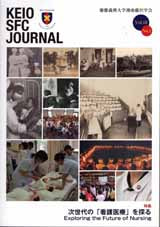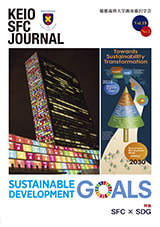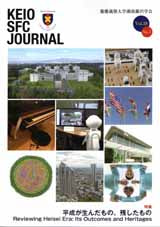- HOME
- KEIO SFC JOURNAL
- Vol.18 No.2

KEIO SFC JOURNAL Vol.18 No.2 Exploring the Future of Nursing
published on 2019.03
Exploring the Future of Nursing
-
Foreword
Download this article (PDF): SFCJ18-2-00.pdfHiroko Komatsu Dean / Professor, Faculty of Nursing and Medical Care, Keio University Tomoko Koike Associate Professor, Faculty of Nursing and Medical Care, Keio University)
-
[Review articles] The Development of Nursing Practice for Cancer Survivorship
Hiroko Komatsu (Dean / Professor, Faculty of Nursing and Medical Care, Keio University) Kaori Yagasaki (Associate Professor, Faculty of Nursing and Medical Care, Keio University) Advances in cancer treatment have led to an increase in the number of cancer survivors who need treatment in their daily lives. The promotion of these survivors'health could be provided via comprehensive, integrated, and long-term survivor care. Toward this goal, we conducted a research project, "The Development of Nursing Practice for Cancer Survivorship." We describe the process and outcome ofthe project, and we discuss additional issues to be addressed. We believe that the accumulation of cancer survivors' narratives will create patient-centered care that will support the individual survivors' care journeys and lives. Future areas of research include the promotion of tailored care and the evaluation and validation of the effects of cancer type and stage-specific nursing care that will support long-term cancer survivorship.
Download this article (PDF): SFCJ18-2-01.pdf -
[Research articles] Development and Evaluation of an Educational Program for Nurses Who Care for Depressive Patients with Cancer
Noriko Fukuda (Associate Professor, Faculty of Nursing and Medical Care, Keio University) Kiyoka Nozue (Professor, Faculty of Nursing and Medical Care, Keio University) Shiori Usami (Professor, Faculty of Life Science, Kumamoto University)) Sayoko Kawano (Certified Nurse Specialist in Mental Health and Psychiatric Nursing, Nursing Department, Keio University Hospital) Aya Midorikawa (Research Associate, Faculty of Nursing and Medical Care, Keio University) Ryoko Kakehi (Lecturer, Tokyo Health Care University) Sakiko Kondo (Nurse Manager, Nursing Department, Keio University Hospital) Chie Uchida (Nurse Manager, Nursing Department, Keio University Hospital) Kiyomi Touda (Nurse Manager, Nursing Department, Kumamoto University Hospital) The purpose of this study was to develop and evaluate an educational program aimed to improve nurses' ability to assess and care for depressive patients to prevent worsening and to improve their mental state. The subjects were 46 nurses working at a hematology unit. The results of this study suggest that this program improves nurse's knowledge, difficulties in care, and self-efficacy regarding communication with patients.
Download this article (PDF): SFCJ18-2-02.pdf -
[Review articles] Challenges Accompanying Patient Moving Techniques in the Field of Basic Nursing Education - Suggestions of Nurses' Low Back Pain Prevention with an International Perspective
Aya Yamamoto (Assistant Professor, Faculty of Nursing and Medical Care, Keio University) This paper summarizes historical transitions in patient moving techniques within basic nursing education, and compares the United Kingdom and Australia with Japan regarding low back pain prevention measures for nurses. Despite the high pain occurrence rates in Japan, the prevention has been a mere duty to make efforts, providing guidelines. In two countries, there has been legislation to completely eliminate the patient moving through human effort, with specific standards such as possible actions/weights. It was suggested that Japan should also implement the "no lift" policies, incorporating in the basic nursing education, and consider human engineering when establishing safe/comfortable patient moving techniques.
Download this article (PDF): SFCJ18-2-03.pdf -
[Practice reports] Initiation and Transition of Midwifery Education at Keio University
Yoshie Kondo (Professor, Faculty of Nursing and Medical Care, Keio University) Keiko Tsuji (Associate Professor, Faculty of Nursing and Medical Care, Keio University) Michiyo Harada (Assistant Professor, Faculty of Nursing and Medical Care, Keio University) This paper explores the history of midwifery education at Keio University and clarifies relevant changes to identify issues that need to be addressed in future educational activities and management. Midwifery education at Keio University was established in 1922 with the "Keio University Midwifery Training School" and continued until 1950 along with changes in name, number of student enrollments, the length of the course of study and management style, so as to keep up with the changing times. While it had to be temporarily discontinued because of the introduction of a new system, it was revived following the establishment of the Faculty of Nursing and Medical Care in 2001 and continues to date. We present some of the characteristic features of the current curriculum and an educational evaluation of the midwifery selection course. Amidst the rapidly changing times and increasing diversity of human reproduction practices, the ideal form of midwifery education and the clinical environments in which midwives work are also changing. To meet the needs of women and families, as well as to respond to society's demands, it is important to continue following a vision of midwifery education at Keio University.
Download this article (PDF): SFCJ18-2-04.pdf
-
[Academic trend reports] Advancement of Genomic Medicine and Outlook of Genomic Nursing
Yuko Takeda (Professor, Faculty of Nursing and Medical Care, Keio University) Along with the remarkable progress of DNA sequencing technology, its application to medical diagnosis and treatment has been advancing, genomic medicine is becoming familiar in various fields, and human resource development is becoming an urgent task. In nursing care, nurses, public health nurses, and midwives have been providing care for patients and families with genetic problems, such as single-gene disorder and congenital malformation, etc. Although they have shown great performance, there has been a difficulty in dealing with rapid medical changes. Meanwhile, certified nurse specialist in genetic nursing was created with great expectation for their role. In this article, we will outline the current state of genomic medicine, focus on cancer medicine, an area which use of genomic information is rapidly spreading in diagnosis and treatment, and describe the outlook of genetic/genomic nursing.
Download this article (PDF): SFCJ18-2-05.pdf -
[Practice reports] Pediatric Nursing and Transplantation - Outdoor Activities as Transition Care
Etsuko Soeda (Associate Professor, Faculty of Nursing and Medical Care, Keio University) Almost three decades have passed since the first living donor transplant (LDLTx) was performed in Japan in 1989. Nowadays, many liver transplant children (transplant children) have been achieving long-term survival. However, there are reports about various problems in their adherence with those transplant children who received LDLTx because there was no transition strategy for those children. The objective of this report is to introduce outdoor activities as transition care for transplant children at one of the Japanese liver transplant centers.
Download this article (PDF): SFCJ18-2-06.pdf -
[Review articles] Child Health Nursing in Japan - Comparing with Society of Pediatric Nurses
Etsuko Tomisaki (Assistant Professor, Faculty of Nursing and Medical Care, Keio University) In Japan, the birth rate is declining and social environments for children are changing rapidly. Competent child health nursing is key to addressing these changes. This study has identified eight central issues in the field of child health nursing and examined them in light of observations made by the Society of Pediatric Nurses. Pediatric nurses in Japan face pressing issues around child development, changing perspectives on the family and society, pediatric pathophysiology, and health promotion. Family-centered care is also important. Clinical experience reveals that having clear aims is more effective.
Download this article (PDF): SFCJ18-2-07.pdf
-
[Research articles] Rethinking on Care in Nursing Practice
Mihoko Miyawaki (Professor, Faculty of Nursing and Medical Care, Keio University) In this paper, I rethink on care to improve efficiency and mechanization of task in nursing practice. Care has been recognized as a core concept and the starting point of nursing. However, the progress in technology and nursing sciences have made a difference between theory and practice. Nursing care is the basis of human relationship, is supported by how to face patients and to philosophize about care as a nurse.
Download this article (PDF): SFCJ18-2-08.pdf -
[Review articles] Overview of Caring
Mayumi Tsutsui (Emeritus Professor, Japanese Red Cross College of Nursing / Director of International Collaboration Center) Caring has many definitions which were deferent by theorists. However, there seems to be some similarities through the content analysis. The antecedents were knowledge, art and attitude of nursing, and environment. The consequences were wellbeing of clients, family and nurses, and caring environment. Caring trend, definition, background, research and so on were discussed.
Download this article (PDF): SFCJ18-2-09.pdf
-
[Research articles] Investigation of Actual Activities and Continuation Factors in Places of Cultural Exchange Between Parents and Children Facilitated by Citizen Volunteers
Masako Kaneko (Professor, Faculty of Nursing and Medical Care, Keio University) Miki Sato (Part-time Lecturer, Faculty of Nursing and Medical Care, Keio University) Susumu Fukita (Research Associate, Faculty of Nursing and Medical Care, Keio University) Machiko Miwa (Professor, Graduate School of Nursing, Kyoto College of Nursing) In this research, we clarified the actual activities conducted by citizen volunteers at places for cultural exchange between parents and children, the organizers' reasons for continuation factors. We conducted an interview-based investigation on eight groups that had been active for seven to twenty-two years, and that were receiving financial support from the government. Volunteers felt that connections among mothers and between children and volunteers where being formed at these places. They stated that the voluntary division of roles in these places. We believe the following aspects are related to the continuation factors of the organizers ability to receive funds and obtain manpower of operation feeling a sense of accomplishment, and the ability to intrinsically motivate the organizers.
Download this article (PDF): SFCJ18-2-10.pdf -
[Progress reports] Current Status and Tasks for Information Sharing among Visiting Nurse Station and Other Home Care Agencies
Satoko Nagata (Professor, Faculty of Nursing and Medical Care, Keio University) To determine the current status of information sharing among visiting nurse stations (VNS) and other home care agencies, a mail survey was conducted with 1,500 VNS around Japan. Of these, 669 responded. While approximately half of those used email or SNS to share information with the attending doctors, 70% did not use email or SNS with visiting helper stations (VHS). In terminal care settings, the telephone was the most widely-used means to share information with certified care managers (CCM), while communication with VHS was largely made via CCM and correspondence notebooks placed in patients' homes. It is clear that there is a lack of progress in information sharing using digital devices, especially for VHS.
Download this article (PDF): SFCJ18-2-11.pdf -
[Practice reports] Patientology: Lessons from Patients, Lessons for Patients
Shinzo Kato (Professor, Faculty of Nursing and Medical Care, Keio University) A forum entitled "Patientology" started in October 2014, and will count its 50th gathering by the end of 2018. The Patientology Open Forum brings together students from nursing and medical schools, various medical professionals, to meet with patients and the community. The goal of the Open Forum is to create a nurturing space to jointly learn effective communication skills. Our main aim has been to review the relationship between the two communities: the patients and the caregivers. In the years ahead, with countless and even unimaginable social changes to come, a better understanding between patients and the medical staff will be of increasing importance. In this review, "Patientology", I will describe the outcomes and lessons learned from the Patientology Open Forum.
Download this article (PDF): SFCJ18-2-12.pdf -
[Progress reports] Burnout Intervention - A Pilot Study of Six Strategies for Improving Your Relationship with Work
Shinya Masuda (Professor, Faculty of Nursing and Medical Care, Keio University) This study described the burnout intervention case of home care service provider using "six strategies for improving your relationship with work". Male participant responded Maslach Burnout Inventory-General Survey and Your Relationship with Work Test at both pre- and post-intervention. Although the results of these questionnaires at pre-intervention revealed that the mismatch in reward and fairness area of his relationship with work was the biggest problem for him, he created action plan to deal with the leadership problem of his workplace. After two months, his burnout level obviously reduced. In addition to this, job problems also reduced not only in the area of control but also in the other areas as a result of his actions.
Download this article (PDF): SFCJ18-2-13.pdf
-
[Practice reports] Creation of an Evaluation Framework That Can Be Used in the Development of Nursing-care Robots by Interdisciplinary Teams
Kikuko Ota (Professor Emeritus, Keio University / Professor, Japanese Red Cross College of Nursing) Junko Masuya (Associate Professor, Graduate School of Human Health Sciences, Tokyo Metropolitan University) Mika Hirao (Research Associate, Faculty of Nursing and Medical Care, Keio University) Yuriko Mashida (Doctoral Program, Graduate School of Health Management, Keio University) There is a concern about the lack of care workers due to Japan's "superaging" society, and expectations for robotic assistance in the provision of nursing care are increasing. Development of nursing-care robots should aim at maintaining and improving the quality of life of the elderly by supporting their independence and reducing the burden on caregivers. We have developed a nursing-care robot by organizing interdisciplinary teams consisting of experts in science and engineering, rehabilitation, nursing science, and product developers. While performing diverse reviews of our prototype's capabilities, we created an evaluation framework for use in nursing-care robot development. In addition, we are planning to develop nursing- care robots that enrich our lives by incorporating human-friendly displays of feelings.
Download this article (PDF): SFCJ18-2-14.pdf -
[Research articles] Nursing xFab - Toward Care Empowered by Needs Triggered Fabrication
Shoko Miyagawa (Associate Professor, Faculty of Nursing and Medical Care, Keio University) The dissemination of digital fabrication devices such as 3D printers enables us the creative micro inventions to adapt various individual needs. In this paper, the author focuses on nursing care, which requires a respect for individuality and describes the current effort and micro inventions to adapt individual needs in nursing care field. Also the current result of the practical research called "FabNurse" is described. Further, the technical and social challenges to disseminate introduction of digital fabrication into nursing care are discussed.
Download this article (PDF): SFCJ18-2-15.pdf -
[Review articles] Innovative Development of an Eye-glass Type Wearable Sensor and Its Application in Sports and Various Activities
Toshiro Otani (Professor, Faculty of Nursing and Medical Care, Keio University) Takeshi Hashimoto (Associate Professor, Sports Medicine Research Center, Keio University) We recently developed an eye-glass type wearable motion sensor (JINS MEME, JINS Inc., Tokyo, Japan) with a three axis acceleration sensor and an angular velocity sensor built into the right temple; and an electro-oculogram sensor built into the nose pad. In this paper, we validated running motion analysis using this wearable sensor device, and utilized it to analyze the motion during a Judo break-fall, and thick-soled shoes walking. Results from these analyses indicate that this wearable device will be useful in both prevention of sports related injuries and help people live a healthy life.
Download this article (PDF): SFCJ18-2-16.pdf
-
[Review articles] Primary Health Care and Global Health - 100 Years of Global Health and What Is Required in the 21st Century
Rika Fujiya (Assistant Professor, Faculty of Nursing and Medical Care, Keio University) In early 20th century, the first international organization in public health beyond national framework was established and 100 years passed. The Definition of Health by WHO which established after World War II has been used internationally even now 70 years later. In addition, Primary Health Care advocated by Declaration of Alma-Ata in 1978 raised the goal of Health for All and had a strong purpose to resolve health disparity. In the 21st century, PHC is regarded as an indispensable activity for achieving Universal Health Coverage, which is regarded as one of the most crucial issues of Global Health, and its importance has been re-recognized.
Download this article (PDF): SFCJ18-2-17.pdf
-
[Practice reports] Comparison of Support for Refugees from Private and Public Organizations in Hong Kong - The Role of the Intimate Sphere in Support for Refugees
Daichi Ishii (Master's Program, Graduate School of Media and Governance, Keio University) The author did the internship to support refugees in Hong Kong. Based on the internship experience, this paper compares private organizations that attempt to form the intimate sphere and public organizations that are required to care everyone. Considering limitation of both entities due to resource limitations and social demand, it is suggested that they should collaborate to sustain an intimate sphere, which can be converted to counter the public sphere, in private organizations.
Download this article (PDF): SFCJ18-2-18.pdf

